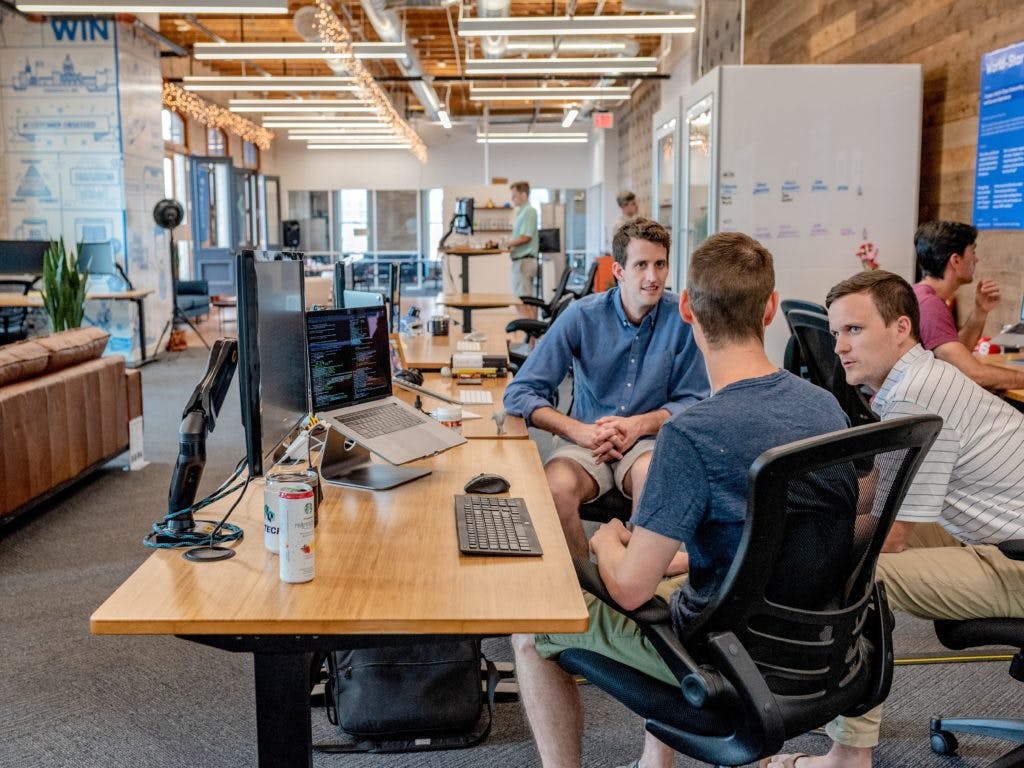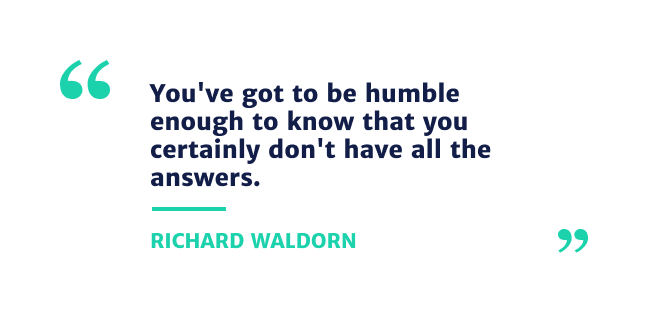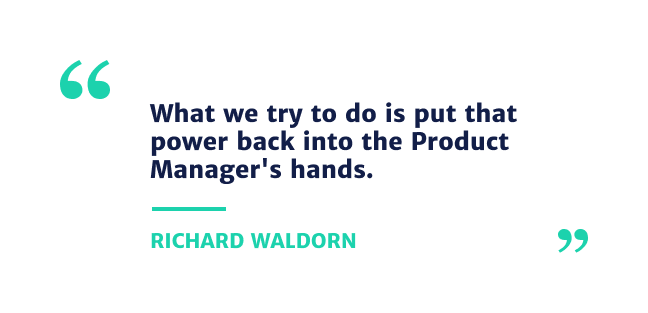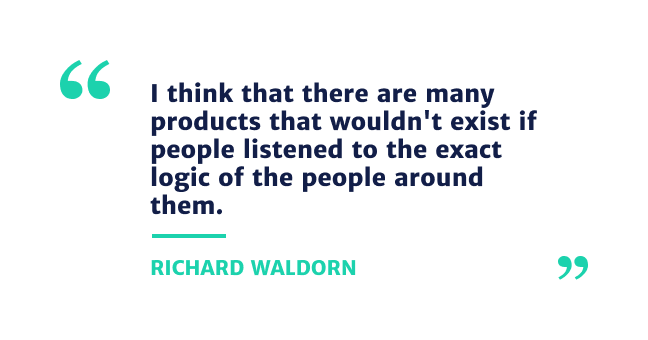Season 3 - Episode 7
The Future of Growth
Richard Waldron is the Founder and CEO of Tray.io, Tray.io is a General Automation Platform that allows its users to take control of their data by automating different processes. Richard talks us through the journey of his business, adapting to new scenarios, understanding your customers and more.

Watch The Episode Here: The Future of Growth
“Question [00:02:57] Why don’t you give me more details about your company and then yourself?”
Richard [00:03:02] Sure. Tray.io has been around now since 2012. There were three of us that started the company back then and the division for us, the idea for us, was to enable less technical people to utilize APIs and the technology that we had available to us. Back then, we had this big bet that more and more people were going to consume more and more software and more and more individualized SaaS tools. And as they did, providing configurability via an API would be a huge asset to them.
You kind of have this challenge where you have the people that use the tools, they understand the business, the importance behind them, but they don’t have the technical skillset to go and expand that usage and build automation around it. So for us, we wanted to find a way that we could harness that technology and enable people to do a lot more with tooling that they already had. That really was the birth of Tray. It took us a very long time to build out the product, took us the best part of four years of, uh, you know, grinding out on the engineering side. As you point out, I think we’ve come on the scene in the last three or four years or so. And it’s really picked up pace in the last, I would say two to three years. So we’re excited to come and talk on shows like this.
“Question [00:06:09] What is the scale of your business today?”
Richard [00:06:13] So from a scale perspective, we’ve grown exceptionally quickly over the last few years. We currently have just under 250 people working at Tray. We are headquartered in San Francisco, we have thousands of customers and we’re at a point now where we do billions of transactions across the platform every month. That was always the dream that we would get to this point where people would be able to come and talk to us about our product suggests ideas, it would have an impact on their job and their career and enabled them to do something that they would’t have been able to have done otherwise. For a long time, as we were building the product and coming around to doing that, that was the thing that was the most exciting about this, one day maybe we could be one of those companies where their technology is utilized in that way. It’s been really exciting to get to this point and we feel like it’s just kind of just kicking off really.

“Question [00:09:43] How did you learn to become CEO? What was some of those breakthroughs that you had to adapt to the new scenario?”
Richard [00:09:52] I think it’s the CEO role is glamorized a lot, but I think it’s like anything, you’ve gotta be prepared to learn. You’ve got to be humble enough to know that you certainly don’t have all the answers. And the key for me was always finding people that were at least two or three major steps ahead and trying to learn from them and get ahead of things that I wasn’t aware that was going to happen or, pick up the stuff that was further down the line. Being able to communicate really clearly, we’ll get you out of a lot of difficult situations as you scale quickly.
You are learning on the job as a CEO, but it never ends. I think the scale that we’re at today will be very different to the scale that we’re at in a year’s time. And the people that are able to grow through those stages are able to continually reinvent themselves in the same way that you think about a product roadmap itself. How do you, get your product ready for the next level of scale? It isn’t that different from how you think about how you scale yourself and present yourself to be able to provide for people that work at the company, as you continue to go through those motions.

You might also be interested in: 6 Product Managers Who Became CEOs—and How!
“Question [00:11:58] How do you see product managers interacting with your product?”
Richard [00:12:04] Tray at its essence is an enabling technology. What we do is we bring an ability and a skill set to people that don’t have the fundamental technical background or requirements to go out and do these things. From a product management perspective, this is particularly prevalent in thinking through integrations and connecting into other platforms. As you know from being a product manager, as you think about scaling your own product, you have to think about how you tackle getting into additional ecosystems, the value of the data that gets either streamed through you, or you provide back out to create that network effect. What’s particularly challenging about that is how you scale and connect all of those different platforms from an engineering standpoint. If you think about it from a purely engineering resource perspective, if you have a team of engineers, you want them working on product functionality, you don’t want them adding, working on supporting and scaling integrations, and yet the people that understand the business purpose of these integrations are the product managers. They’re the ones that can tell you why this is going to be valuable for that customer, why that’s going to make a difference, why it needs to work in that specific way.

What we try to do is put that power back into the Product Manager’s hands, Tray embedded platform allows you to effectively connect to over 500 different services out the gate, and you can build integrations within our service, in a visual way as a product manager that will enable your end customers to connect to these other tools. It’s done in a completely white label fashion. What that essentially allows you to do is your removing the burden of scaling out all these integrations from an engineering perspective, you’re putting the power back in the product manager’s hands, and you’re able to get the measurable ROI of that because we provide all the reporting and insight that comes with doing so. That itself kind of shows you the way that this trend is moving.
I think , engineers, you want them working on gnarly and difficult technical problems. They’re the people that can go and bring those things to life. For the bits that need interconnecting for the parts where you are transforming data or connecting different services together, a platform like Trays is the ideal way to go out and do that. And that’s, the vision that we had, that’s the thing that we’re trying to bring to the world.

“Question [00:16:24] How do you go about understanding your customers and prioritizing the next set of integrations or the next big thing for your product?”
Richard [00:16:35] I have a slightly different view to the way many products are conceived or even best practices considered, in that well thought out and executed product idea through to delivery, involves a lot of analysis. A lot of customer interviews, a lot of other stages that effectively will reduce risk as you go through to launch. For us, we really didn’t do much of that. We were so passionate about the problem that we were solving, we were so clear on how we wanted this product to be that we ignored most of the fundamentals of built in exactly the way that you’re not meant to. I think whilst I’m not a complete advocate of that, I think it is important in some ways. I think that there are many products that wouldn’t exist if people listened to the exact logic of the people around them, or perhaps weren’t very good at asking the right questions, but you have to build the things that you’r gut tells you to get this thing off the ground now, where that evolves is as you scale through.

As you found that product market fit and approach position becomes key. I think there are two tracks that you have to be aware of here. One is understanding your customers intimately today and understanding the needs that they have, not only in scaling and maintaining on the platform that you have, but the things that you aren’t able to do for them that are valuable. And that involves a lot of customer work, a lot of customer interaction. It involves joint workshops. It involves getting as close to your customer as you humanly can. And then secondarily on the other track is you’ve got to be well ahead from an innovation standpoint, you’ve got to be thinking about where are you aiming at from a product perspective? What are the changes that you think are going to kind of come two to three years down the line? How do you ensure that you’re always pushing yourself to innovate toward those?
It’s a tough thing to balance because, from an investment perspective, you’ll want to make sure that you’re doing the right thing by the customer all the time. But if you lose that innovation streak, then you’ll become the incumbent that you’re trying to replace in the market. And the prioritization piece is important for us from an integration perspective, we’ve built out a lot of tooling, which puts that back in the hands of our customers. And as a result, they can actually, the more tooling that you can build that allows them to go and solve their own problems. The more powerful you become as a platform. And we very much take that view. That was the early ethos of the service should be that you shouldn’t be restricted by the things that we build. You should always be able to go and expand your usage beyond that.

“Question [00:22:18] What are those major themes that you like to invest your time in?”
Richard [00:22:24] It changes so frequently, if you think about a fast growth company, you’re basically packing years of growth into probably six month periods. So at any point, your role as CEO evolves very quickly in different directions. Over time for me, the key changes have been, working with our executive team, leading the hiring for future executives, working very closely on the strategy side, and that is essentially making sure that, you know, you’re all driving in the right direction. That means aligning and working closely with your board. It means aligning and directing the company from a vision perspective to where you’re trying to get what sort of product you’re trying to build, and importantly, the culture that it takes to get there. And then a lot of that comes down to how you message and work with your fellow executives, because they then represent that within each aspect of their team. And it all has to cascade together in the right way.
So for me a lot of my time is spent on meetings, working with people, driving and enforcing the things that are important to the company at any given time. But most importantly, my role is to enable everybody else. I regularly tell people that I’m the least skilled person in the company. I’m the one there to make sure that all the people that are great at the specific roles that they have are enabled to go out and do that. And for me to get out of the way to help drive that. As you go through those stages, those are the kinds of changes that happen. There’ll be a time where your head down on fundraising and building investor relationships for a very long time. But I think you’ve gotta be, clear and driving that strategy is the is the most important aspect of the role, in my opinion.
We’ll be back next week with Mariano Suarez Battan from Mural with even more of the latest insights from the Product Management world.
Listen to our episodes on your favorite platform
Stay tuned for new episodes
By sharing your email, you agree to our Privacy Policy and Terms of Service






